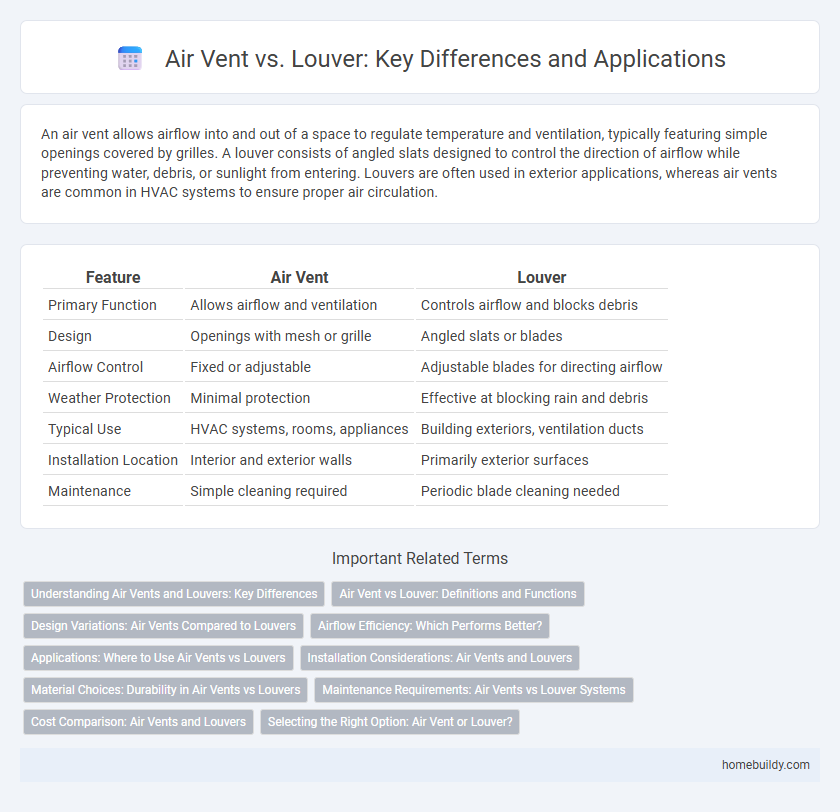An air vent allows airflow into and out of a space to regulate temperature and ventilation, typically featuring simple openings covered by grilles. A louver consists of angled slats designed to control the direction of airflow while preventing water, debris, or sunlight from entering. Louvers are often used in exterior applications, whereas air vents are common in HVAC systems to ensure proper air circulation.
Table of Comparison
| Feature | Air Vent | Louver |
|---|---|---|
| Primary Function | Allows airflow and ventilation | Controls airflow and blocks debris |
| Design | Openings with mesh or grille | Angled slats or blades |
| Airflow Control | Fixed or adjustable | Adjustable blades for directing airflow |
| Weather Protection | Minimal protection | Effective at blocking rain and debris |
| Typical Use | HVAC systems, rooms, appliances | Building exteriors, ventilation ducts |
| Installation Location | Interior and exterior walls | Primarily exterior surfaces |
| Maintenance | Simple cleaning required | Periodic blade cleaning needed |
Understanding Air Vents and Louvers: Key Differences
Air vents facilitate airflow regulation and ventilation within buildings by allowing air passage while preventing debris entry, whereas louvers consist of angled slats designed primarily for directing airflow and blocking rain or sunlight. Louvers offer better protection against external elements and provide aesthetic control, but air vents are essential for maintaining indoor air quality and pressure balance. Understanding these differences helps optimize HVAC system efficiency and building ventilation design.
Air Vent vs Louver: Definitions and Functions
An air vent is a designed opening or grille that facilitates the flow of air into or out of a space, promoting ventilation and maintaining indoor air quality. Louvers consist of parallel slats angled to allow air passage while blocking rain, debris, or direct sunlight, often used as protective covers for air vents or windows. The primary function of air vents is air exchange, whereas louvers focus on controlling airflow and environmental elements without obstructing ventilation.
Design Variations: Air Vents Compared to Louvers
Air vents feature a variety of design variations including fixed or adjustable blades to control airflow, while louvers often have angled slats to prevent rain and debris entry. Customizable sizes and materials such as aluminum, steel, or plastic distinguish air vents by allowing tailored ventilation performance and aesthetic appeal. Louvers prioritize weather resistance and airflow direction, whereas air vents emphasize versatile airflow control and integration with HVAC systems.
Airflow Efficiency: Which Performs Better?
Air vents typically offer higher airflow efficiency compared to louvers due to their open design, allowing more air to pass through with minimal resistance. Louvers, designed primarily to prevent rain and debris from entering, often restrict airflow by using angled slats that obstruct direct air passage. For ventilation systems prioritizing maximum airflow, air vents provide better performance and improved energy efficiency.
Applications: Where to Use Air Vents vs Louvers
Air vents are ideal for indoor applications requiring efficient airflow and ventilation, such as HVAC systems in residential and commercial buildings, where air exchange is crucial for maintaining air quality. Louvers are better suited for exterior use, especially on building facades and mechanical rooms, providing weather protection while allowing airflow and preventing debris entry. Choosing between air vents and louvers depends on factors like location, exposure to elements, and the need for airflow regulation versus environmental protection.
Installation Considerations: Air Vents and Louvers
Air vents require careful placement to ensure optimal airflow and pressure balance within HVAC systems, often involving straightforward duct connections and wall or ceiling mounting. Louvers, designed for exterior installation, must be securely fastened to building facades with weather-resistant seals to prevent water intrusion and debris entry while maintaining ventilation efficiency. Both installations demand compliance with building codes and consideration of the surrounding environment to maximize performance and durability.
Material Choices: Durability in Air Vents vs Louvers
Air vents commonly feature materials like galvanized steel, aluminum, and plastic, offering robust durability against corrosion and environmental wear. Louvers are generally constructed from aluminum or stainless steel, enhancing resistance to harsh weather and mechanical impact. The choice between air vents and louvers often hinges on the specific durability needs associated with their material composition and intended application.
Maintenance Requirements: Air Vents vs Louver Systems
Air vents typically require less maintenance compared to louver systems due to their simpler design and fewer moving parts. Louvers, featuring adjustable slats, demand regular inspections and cleaning to ensure proper airflow and prevent debris buildup. Routine maintenance for louvers often involves lubrication of mechanical components and checking for damage to maintain optimal performance.
Cost Comparison: Air Vents and Louvers
Air vents generally cost less than louvers due to simpler design and materials, making them a budget-friendly option for basic airflow needs. Louvers, featuring adjustable slats and more durable construction, often involve higher installation and maintenance expenses. Choosing between air vents and louvers depends on balancing upfront costs with long-term functionality and aesthetic preferences.
Selecting the Right Option: Air Vent or Louver?
Selecting the right option between an air vent and a louver depends on airflow control and environmental protection needs. Air vents provide direct ventilation and are ideal for improving indoor air quality in HVAC systems, while louvers offer adjustable blades to regulate airflow and block debris or water intrusion. Understanding the specific requirements of your space, such as ventilation efficiency and weather resistance, ensures optimal selection for energy savings and comfort.
Air vent vs Louver Infographic

 homebuildy.com
homebuildy.com